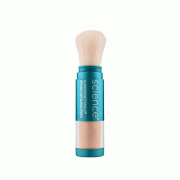Understand Your Skin Type To Have The Best Skin Care Routine For YOU
Here at Urban Body Laser, we realize that determining your skin type may feel a little overwhelming, like cracking a super cryptic code or searching for the missing piece of a complex genetics puzzle but it is an absolute necessity when it comes to ensuring proper skincare and overall skin health and longevity.
Knowing (and understanding) your skin type is the first step in the right direction to determining why you could be experiencing certain skin-related concerns and establishing a vital skincare routine – the basis on which all your products and regimens rest.
It will also aid in understanding your skin’s natural behaviors and responses, enabling you to introduce to your routine, better-suited products that are most effective for you, to target skin concerns specific to your own skin.
We would love to help you establish what your skin needs to look and feel its best but in order to do this, you must first understand the different skin types and determine your own skin
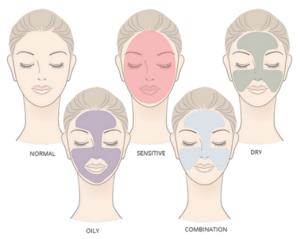
type…
Understanding the Different Skin Types
There are five main types of skin, namely: normal, dry, oily, combination and sensitive skin. Skin type is predominantly determined by genetics. However, the condition of our skin may vary greatly in accordance with the various internal and external factors it is subjected to, such as climate, hormones, medications, diet and products, to name a few.
1. Normal Skin Type
What is “normal” skin?
 The term ‘normal’ skin is widely used to refer to well-balanced skin. The scientific term for well-balanced skin is eudermic. Normal skin: is neither overly oily nor dry; is rarely sensitive or particularly problematic; has balanced sebum production and good blood circulation. This well-balanced healthy skin type has even levels of moisture and hydration, uniform texture and no obvious problem areas.
The term ‘normal’ skin is widely used to refer to well-balanced skin. The scientific term for well-balanced skin is eudermic. Normal skin: is neither overly oily nor dry; is rarely sensitive or particularly problematic; has balanced sebum production and good blood circulation. This well-balanced healthy skin type has even levels of moisture and hydration, uniform texture and no obvious problem areas.
How to identify normal skin
Normal skin may be identified by the following properties:
- Barely visible pores
- A fresh, even tone
- Soft and smooth texture with uniform transparency
- Good blood circulation
- Balanced oil production
- No blemishes and
- Minimal sensitivity
As a person with normal skin ages, their skin may become drier.
2. Dry Skin Type
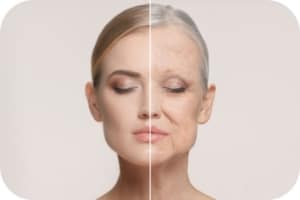
What is “dry” skin?
The term ‘dry’ skin is used to describe a skin type that produces insufficient sebum and as a result, dry skin lacks the lipids it requires to retain balanced moisture and build a protective shield against harsh external influences (this leads to an impaired barrier function). Often characterized by its flaky and rough texture, dry skin (or Xerosis) exists in varying degrees of severity and in different forms that are not always obviously distinguishable.
Significantly more women suffer from dry skin than men, and all skin gets dryer as it ages.
The causes of dry skin
Dry skin may affect anyone but some risk factors raise your chances of developing dry skin. These include:
- Age: as you age, your pores naturally produce less oils
- Medical history: you’re more likely to experience eczema or allergic contact dermatitis, if there is a history of these conditions in your family
- Seasons: dry skin is more common during the colder months, when humidity levels are relatively low. In warmer months, higher levels of humidity may prevent your skin from drying out.
- Cleansing habits: taking long and frequent baths, showers or cleansing with very hot water strips the skin of its necessary oils
Skin moisture is dependent on water supply in the deeper skin layers and even perspiration. Skin is constantly losing water via:
- Perspiration: active water loss from the glands caused by heat, stress or exertion and is vital for body temperature regulation and overall health.
- Trans-epidermal water loss (TEWL): the skin’s natural and passive process of water content regulation by diffusing about half a liter of water a day from the deeper skin layers.
Therefore, dry skin is caused by a lack of:
- Natural moisturizing factors (NMFs): especially urea, amino acids and lactic acid – that help to bind in water.
- Epidermal lipids: such as ceramides, fatty acids and cholesterol which are needed for a healthy skin barrier function.
As a result, the skin’s barrier function may become compromised.
How to identify dry skin
Dry skin ranges from skin that is a little bit drier than normal, to very dry skin, to extremely dry skin.

These differences are normally be distinguished by:
Dry skin
- Flaky, rough or tight feeling
- Slight itchiness
- Brittle, uneven texture
- Dull looking
- Low elasticity
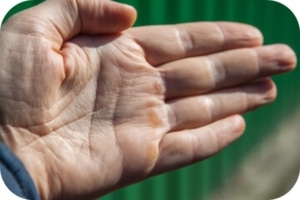
Very dry skin
- Mild scaling or patched flakiness
- Rough and blotchy appearance (may appear to be prematurely aged)
- Feeling of tightness
- Itchiness
- More sensitive to irritation, redness and risk of infection
 Extremely dry skin
Extremely dry skin
- Roughness and inflammation
- Chapping, fissures (cracks) and/or calluses
- Scaling
- Discoloration
- Frequent itchiness
Extremely dry skin is most commonly found on the elderly or on severely dehydrated hands.
3. Oily Skin Type
What is “oily” skin?
The term ‘oily’ skin describes a skin type with heightened sebum production. This excessing discharge of sebum is commonly known as seborrhea.
The causes of oily skin
A number of issues may trigger an overproduction of sebum. These include:
- Genetics: oily skin tends to run in families. If one of your parents has oily skin, you’re likely to have overactive sebaceous glands, too
- Stress and hormonal changes: androgens (the hormones mostly responsible for oil production) may sometimes fluctuate, stimulating an increase in sebum production, occurring most commonly during puberty, pregnancy and menopause. Stress and illness may also prompt for additional hormones to be released, and with those hormones excess oils may be produced
- Medications: acquiring oily skin is one of the possible side effects associated with taking oral contraceptives, hormone replacement medication and certain kinds of steroids. Some medications may also cause dehydration which leads to the production of excess oils
- Enlarged pores: sometimes pores stretch out due to age, weight fluctuations and previous breakouts – larger pores tend to produce more oil
- Environment: where you live and the time of year may contribute to oily skin. People in warmer, humid climates tend to have oilier skin. You are also likelier to have more oil on your skin during warmer seasons than you would in colder seasons
- Poor diet: frequent consumption of foods high in sugars, refined carbohydrates and dairy may lead to overactive sebum production
- Comedogenic cosmetics: frequent use of cosmetic products that cause irritation
- Methods of cleansing: scrubbing too hard and too often, with abrasive tools or coarse exfoliators, and using harsh chemicals and soaps not suited for your skin type, strips the skin of moisture causing glands to overproduce oil
How to identify oily skin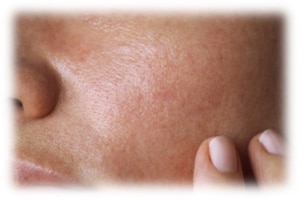
Oily skin may be identified by the following properties:
- Enlarged, obviously visible pores
- Greasy appearance
- Thicker, pale skin: blood vessels may not be visible
- Prone of breakouts
- Inflammation and discoloration in severe cases
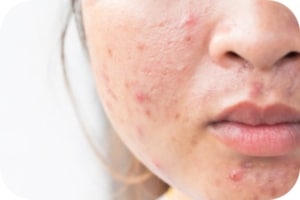 Oily skin is prone to comedones (blackheads and whiteheads) and to other varying forms of acne.
Oily skin is prone to comedones (blackheads and whiteheads) and to other varying forms of acne.
With mild acne, a significant number of comedones appear on the face and frequently on the neck, shoulders, back and chest too.
In moderate and severe cases, papules (small bumps with no visible white or black head) and pustules (medium sized bumps with a noticeable white or yellow spot at the center) appear and the skin becomes red and inflamed.
4. Combination Skin Type
What is “combination” skin?
The term ‘combination’ skin describes exactly that – having a combination of oily skin in some areas and dry skin in other areas. Typically, there’s a mix of oily and dry areas on different parts of your face, with the T-zone (forehead, nose, and chin) being slightly to very oily and the cheeks being normal to dry.
The causes of combination skin
The oilier parts of combination skin are caused by an overproduction of sebum. The drier parts of combination skin are caused by a lack of sebum and a corresponding lipid deficiency.
A number of factors may cause combination skin. These include:
- Genetics: if one of your parents has combination skin, you’re likely to have it too
- Climate: you may see a change in your skin’s appearance depending on the change in the climate. You are likelier to have more oil on your skin during warmer seasons and your skin may feel dry in colder seasons
- Products: the use of harsh products may and contribute to excess sebum production in the T-zone
How to identify combination skin
Combination skin may be identified by the following properties:
- Oily T-zone (forehead, chin and nose)
- Enlarged pores T-zone area, perhaps with some impurities
- Prone to breakouts only on forehead, chin and nose
- Normal to dry cheeks
- Sensitive cheeks
5. Sensitive Skin Type
What is “sensitive” skin?
The term ‘sensitive’ skin generally refers to skin that is more prone to inflammation or adverse reactions. People with sensitive skin are likelier to have strong, negative reactions to chemicals, dyes, and fragrances present in products that come into contact with the skin.
The causes of sensitive skin
Just like there are varying degrees of severity of dry skin, there are also different levels of sensitive skin. These may generally be divided up into four main types, namely, naturally sensitive, environmentally sensitive, reactive, and thin.
- Naturally sensitive skin: the cause of this is genetics and may be linked to inflammatory skin conditions such as eczema, psoriasis and rosacea
- Environmentally sensitive skin: this type of sensitivity, as the name implies, is triggered by the environment. Factors such as sun exposure, cigarette smoke, air pollution that come into contact with the skin may cause irritation
- Reactive skin: direct contact with certain products may cause the skin to react, becoming irritated, resulting in papules or pustules, warmness, redness and/or inflammation forming, where the irritant came into contact
- Thin skin: as we age, our skin naturally becomes thinner, and thinner skin is easier to irritate
How to identify sensitive skin
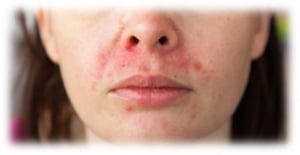
Sensitive skin may be identified by the following properties:
- Skin feeling itchy and tight
- Uneven texture
- Oily in warmer seasons
- Dry in colder seasons
- Reacts easily to certain skincare products
- Redness after a hot water application (bath or shower)
- Feels itchy while wearing tight clothes
- Flushes easily after eating spicy food
If you need help with identifying your skin type, we’ve included below a very basic skin type test, which may be a useful tool:
Determining Your Skin Type
If…
• Your skin doesn’t get more oily or drier during the day
• You only experience dry parches or excess oil seasonally
• You rarely experience breakouts or are sensitive to products
Your skin type is likely…

If…
• You experience dry patches or flaking skin mid-day
• Your skin is rare oily, even at the end of the day
• Your skin often feels tight, itchy, or dry after cleansing
Your skin type is likely…

If…
• Your face is shiny or greasy by mid-day, regardless of the season
• You frequently experience breakouts
• You have large and visible pores
Your skin type is likely…
 If…
If…
• Your T-zone is consistently oily and your cheeks are often dry
• Your visible pores are concentrated in your T-zone area
• You experience acne and dry patches at the same time
Your skin type is likely…

If…
• You often experience redness or irritation after applying new products or products with ingredients, like fragrance
• You have skin conditions like rosacea, eczema, or psoriasis
Your skin type is likely…

However, if you need further advice, we highly recommend that you contact us for a free consultation.
Evaluating skin type and condition
Unlike skin type, skin condition may vary greatly during a person’s lifespan. There are many internal and external factors that determine and affect its condition, including: climate and environment, medication, stress and illness, hereditary traits which influence the levels of sebum, perspiration and natural moisturizing factors that your skin produces, and even the products you use and the skincare choices you make.
Skincare products should ideally be selected to match skin type and address skin condition. Dermatologists and other skincare experts determine a person’s skin type condition by measuring the following factors:
 Signs of Aging
Signs of Aging
Our skin type can evolve during our lifetime. Those with an oily skin type in their teenage years can find their skin becoming drier post-puberty and those with a normal skin type can find their skin getting drier as they age.
As all skin types age, skin loses elasticity, volume and density, fine lines and wrinkles appear and changes in pigmentation can occur. Understanding and measuring the signs of ageing helps us to determine the condition of our skin.
Skin Color
Skin color and ethnicity influences how our skin reacts to external forces such as the sun, pigmentation disorders, irritation and inflammation. Basic skin color is determined by the density of the epidermis and the distribution of melanin.
The redness of skin is also a useful measure of skin condition; it indicates how successful our circulation is and is helpful in identifying conditions such as couperose (or rosacea).
Sebum and Sweat Production
The amount of sebum produced by the sebaceous glands in skin controls the efficacy of the skin’s barrier function and, as a result, the condition of skin. The overproduction of sebum can lead to oily, acne-prone skin, while low sebum production causes dry skin.
The perspiratory glands in skin produce sweat to help the body to maintain its optimum temperature. Excessive or low sweat production can influence skin condition.
Skin Sensitivity
Sensitive skin is skin that is easily irritated and is more reactive to different factors, that are generally tolerated by well-balanced (normal) skin. For some people, sensitive skin is a permanent condition; for others, sensitivity is triggered by certain internal and external factors. It occurs when skin’s natural barrier function is compromised, causing water loss and allowing penetration of irritants. Symptoms are exacerbated by factors that facial skin is most exposed to, from the sun to some ingredients in cosmetics and cleansers. Identifying and evaluating symptoms such as redness, a rash, stinging, itching and burning help in determining skin condition.
Natural Moisturizing Factors (NMFs)
Naturally produced in healthy skin, NMFs such as amino acids help to bind water into the skin, maintain its elasticity and suppleness and prevent it from becoming dehydrated. When the skin’s protective barrier is damaged it is often unable to retain these essential NMFs so skin moisture decreases and condition is affected.
WE ARE HERE FOR YOU!
We sincerely hope that this article has helped you to understand the importance of knowing and understanding you skin type and want you to know that our friendly and qualified staff are always here to give you any recommendation, with utmost passion for skincare.
We proudly invite you to peruse our incredible product range at https://urbanbody.myshopify.com! Our collection of R3 Derma Health products contains the highest concentration of active and natural ingredients, best suited for those individuals who desire faster results.
If you have any further questions, you are welcome to contact us at info@urbanbodylaser.com, live chat or at (604) 265-7507. Or, if you would like to take advantage of our promotional offers, please visit https://www.urbanbodylaser.com/promotions for more information.









